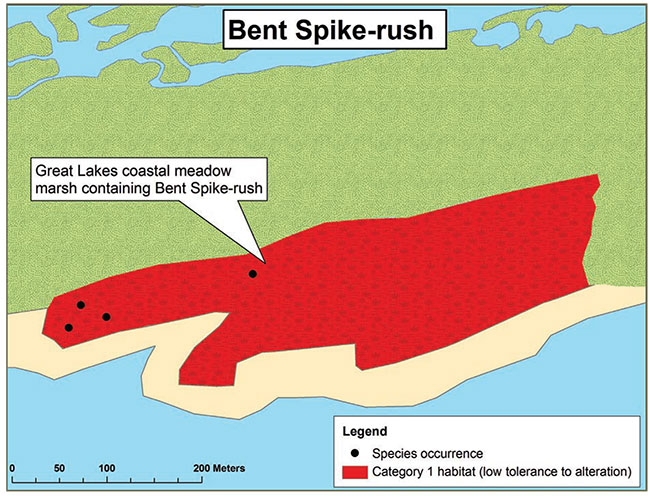Bent Spike-rush Habitat Protection Summary
This document provides a brief description of the area that is protected as habitat for the Bent Spike-rush through a habitat regulation under the Endangered Species Act.
Bent Spike-rush is a small, annual plant that grows on wet, sandy to muddy soils. In Ontario, Bent Spike-rush occurs in Great Lakes coastal meadow marshes and interdunal ponds on the Long Point Peninsula of Lake Erie and on the shoreline of a dug sand pit at an inland site near Rondeau Provincial Park. The species was assessed by the Committee on the Status of Species at Risk in Ontario (COSSARO) and listed as endangered on September 10, 2009. More information about the species' status can be found at: Bent spike-rush.
The regulated habitat of Bent Spike-rush protects the areas where Bent Spike-rush exists, as well as those areas that the species depends on to carry out its life processes (e.g. dispersal, reproduction, growth). This includes the entirety of any interdunal pond, Ecological Land Classification (ELC) ecosite, such as Great Lake coastal meadow marsh, or other area in which a Bent Spike-rush exists, or on which a Bent Spike-rush depends to carry on its life processes.
The regulation applies where the plant occurs in the following areas: the geographic Township of Raleigh within the Municipality of Chatham-Kent, and the geographic Township of Walsingham within Norfolk County.
Supporting rationale
- Bent Spike-rush populations expand, contract, and move in response to changes in lake water levels and sand dunes
- Protecting the area where the species exists as well as the area the species depends on to carry out its life processes supports the dynamic nature of this species
Activities in Bent Spike-rush habitat
Activities in regulated habitat can continue as long as the function of these areas for the species is maintained and individuals of the species are not killed, harmed, or harassed.
Generally compatible:
- Pruning of trees or shrubs
- Removal of individual trees or shrubs
- Normal use of existing roadways including access roads
- Normal use of existing recreational trails
Generally not compatible footnote * :
- Construction of houses, other structures, or roads
- Substantial alteration of surface or ground water levels
- Significant removal of soils or substrates
- Planting of trees or shrubs that could shade out areas used by the species
Key terms
- Great Lakes coastal meadow marsh: An area along the Great Lakes' shoreline at the wetland-terrestrial edge that is seasonally flooded and usually dominated by rushes and reeds, as described in the document entitled Ecological Land Classification for Southern Ontario: First Approximation and its Application, dated September 1998 and published by the Ontario Ministry of Natural Resources
- Interdunal pond: A small body of standing water occurring within a depression between ridges of sand deposited by wind and wave action
Below you will find an example diagram of how this regulation would be applied to protect habitat for this species. It indicates how the protected habitat has been categorized, based on how the species uses the habitat and how much activity or change can occur within the habitat, as per the policy "Categorizing and Protecting Habitat Under the Endangered Species Act".
Sample Application of the Habitat Regulation
Figure 1. Sample application of the Habitat Regulation for Bent Spike-rush.

Enlarge Figure 1. Sample application of the Habitat Regulation for Bent Spike-rush.
The content of this summary is provided for convenience only. For accurate reference and the most recent version of the regulation, please view Ontario Regulation 832/21 on e-Laws
Footnotes
- footnote[*] Back to paragraph If you are considering an activity that may not be compatible with regulated habitat, please contact your local MNR office for more information.